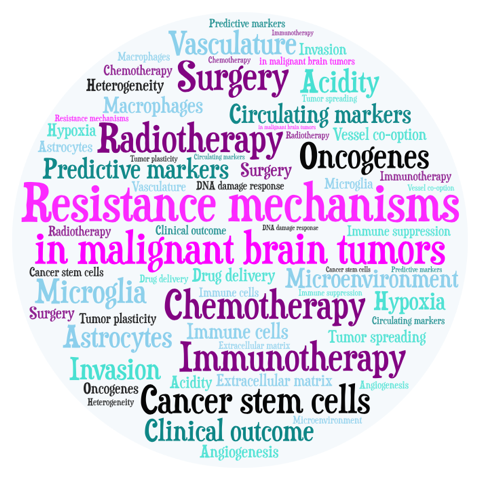Resistance Mechanisms in Malignant Brain Tumors
A special issue of Cancers (ISSN 2072-6694). This special issue belongs to the section "Molecular Cancer Biology".
Deadline for manuscript submissions: closed (31 May 2022) | Viewed by 51877
Special Issue Editors
Interests: glioblastoma; brain tumors; resistance mechanisms; tumor microenvironment; vasculature; vessel co-option; biomechanics
Interests: glioblastoma; metabolism; lactate; tumor invasion; tumor symbiosis; resistance mechanisms
Interests: brain tumors; glioblastoma; tumor heterogeneity; tumor plasticity; cancer stem cells; tumor microenvironment; preclinical models
Special Issue Information
Dear Colleagues,
Brain tumors comprise a broad range of primary and metastatic tumors, with different aggressiveness and clinical outcomes. Glioblastoma (GBM), and secondary metastatic tumors from distant organs, such as melanoma, lymphoma, lung and breast cancers, are among the most deadly and incurable types of human cancer. Despite improved surgical interventions, brain tumors can often be only partially removed, and only a limited amount of progress has been made to improve the patient survival in the recent years. The standard treatments are currently not effective, because malignant brain tumors are highly resistant to therapies, such as radiation, chemo- and immunotherapy. The mechanisms of resistance can be intrinsic or acquired and include:
- Cell-autonomous mechanisms, involving undruggable genomic drivers and pathway reactivation, genomic instability, DNA damage response, intra- and inter-tumor heterogeneity, stem cell features, epigenetics and phenotypic plasticity.
- Tumor microenvironment effects mediated by the complex crosstalk between tumor and non-malignant cells including astrocytes, neurons, vasculature (endothelial cells and pericytes), as well as distinct immune compartment of the brain comprising microglia, resident and blood-recruited macrophages and lymphocytes.
- Microanatomical and biomechanical features of the tumor itself, such as the inefficient drug delivery, hypoxia and acidosis, tumor infiltration and invasion, vessel co-option and angiogenesis.
This Special Issue will focus on the tumor features and mechanisms that convey resistance to therapy in malignant brain tumors. We invite authors to submit contributions that provide novel findings, or reviews that comprehensively highlight the latest discoveries in the field.

Dr. Giorgio Seano
Dr. Thomas Daubon
Dr. Anna Golebiewska
Guest Editors
Manuscript Submission Information
Manuscripts should be submitted online at www.mdpi.com by registering and logging in to this website. Once you are registered, click here to go to the submission form. Manuscripts can be submitted until the deadline. All submissions that pass pre-check are peer-reviewed. Accepted papers will be published continuously in the journal (as soon as accepted) and will be listed together on the special issue website. Research articles, review articles as well as communications are invited. For planned papers, a title and short abstract (about 100 words) can be sent to the Editorial Office for announcement on this website.
Submitted manuscripts should not have been published previously, nor be under consideration for publication elsewhere (except conference proceedings papers). All manuscripts are thoroughly refereed through a single-blind peer-review process. A guide for authors and other relevant information for submission of manuscripts is available on the Instructions for Authors page. Cancers is an international peer-reviewed open access semimonthly journal published by MDPI.
Please visit the Instructions for Authors page before submitting a manuscript. The Article Processing Charge (APC) for publication in this open access journal is 2900 CHF (Swiss Francs). Submitted papers should be well formatted and use good English. Authors may use MDPI's English editing service prior to publication or during author revisions.
Keywords
- brain tumors
- resistance mechanisms
- tumor microenvironment
- targeted therapy
- tumor heterogeneity
- glioblastoma
- brain metastasis
- radiotherapy
- chemotherapy
- immunotherapy
Benefits of Publishing in a Special Issue
- Ease of navigation: Grouping papers by topic helps scholars navigate broad scope journals more efficiently.
- Greater discoverability: Special Issues support the reach and impact of scientific research. Articles in Special Issues are more discoverable and cited more frequently.
- Expansion of research network: Special Issues facilitate connections among authors, fostering scientific collaborations.
- External promotion: Articles in Special Issues are often promoted through the journal's social media, increasing their visibility.
- Reprint: MDPI Books provides the opportunity to republish successful Special Issues in book format, both online and in print.
Further information on MDPI's Special Issue policies can be found here.








